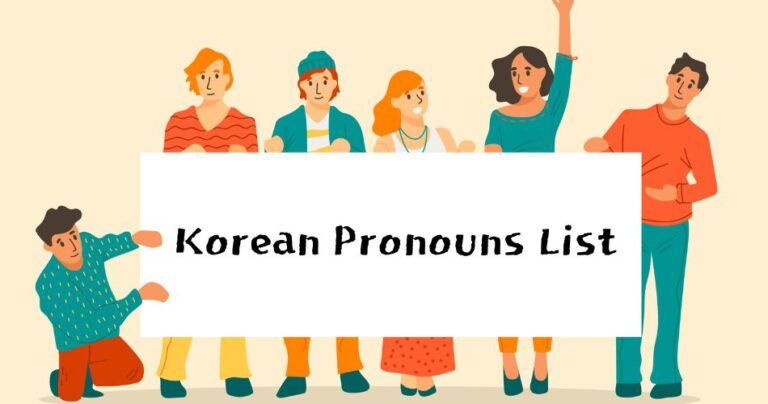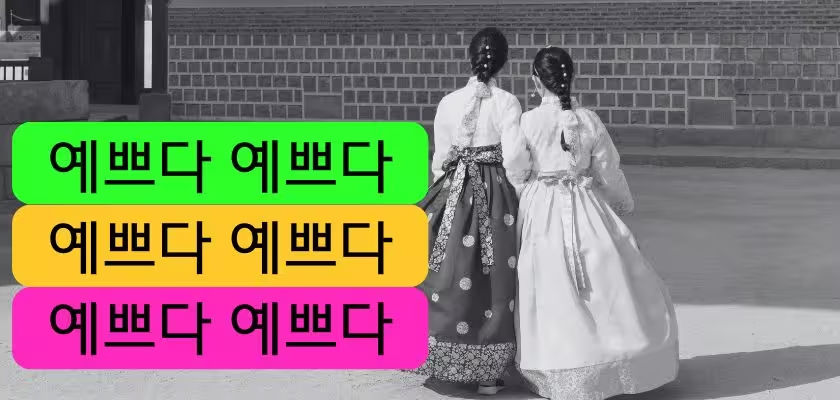In this article, I’ll provide you with a comprehensive Korean pronouns list that will help you navigate conversations and understand Korean culture better.
Understanding Korean Pronouns
Before we dive into the Korean pronouns list, let’s take a moment to understand their significance. Pronouns play a crucial role in any language, as they allow us to refer to people, objects, or concepts without constantly repeating their names. In Korean, pronouns are no exception, and they come in various forms depending on factors such as politeness and formality.
Common Korean Pronouns List
나 (na)
This is part of the Korean pronouns list, and it represents the informal pronoun for ‘I’ or ‘me.’ It’s commonly used among close friends or in casual settings.
Original Korean Sentence
A: 나는 커피가 좋아. B: 나는 차를 더 좋아해.
Pronunciation Guide
A: 나는 (na-neun) 커피가 (keo-pi-ga) 좋아 (jo-a). B: 나는 (na-neun) 차를 (cha-reul) 더 (deo) 좋아해 (jo-a-hae).
Meaning and Context
A: 나 (I) 는 (as for me) 커피 (coffee) 가 (my subject is coffee) 좋 (to like) 아 (I’m telling you casually). B: 나 (I) 는 (as for me) 차 (tea) 를 (my object is tea) 더 (more) 좋아하 (to like) 해 (I’m telling you casually).
Pronunciation Patterns for Conjugations
* 하 -> 해
English Translation
A: I like coffee. B: I prefer tea.
Literal Translation
A: As for me, (I) like coffee. B: As for me, (I) like tea more.

저 (jeo)
The second Korean pronouns list, a more formal way of saying “I” or “me,” often used in polite conversations.
Original Korean Sentence
A: 저는 요리를 잘 못해요. B: 요리 배우면 재미있을 거예요.
Pronunciation Guide
A: 저는 (jeo-neun) 요리를 (yo-ri-reul) 잘 (jal) 못해요 (mot-tae-yo). B: 요리 (yo-ri) 배우면 (bae-u-myeon) 재미있을 (jae-mi-it-sseul) 거예요 (ggeo-ye-yo).
Meaning and Context
A: 저 (I; in a humble way) 는 (my topic is myself) 요리 (cooking) 를 (my object is cooking) 잘 (well) 못 (can’t) 하 (to do) 해요 (I’m telling you polite and friendly). B: 요리 (cooking) 배우 (to learn) 면 (if) 재미있 (to be fun) 을 거 (will) 예요 (be; I’m telling you polite and friendly).
Pronunciation Patterns for Conjugations
* 하 -> 해
English Translation
A: I’m not good at cooking. B: If you learn to cook, it will be fun.
Literal Translation
A: I can’t do cooking well. B: If (you) learn cooking, (it) will be fun.
너 (neo)
Informal “you,” used when addressing close friends or someone younger.
Original Korean Sentence
A: 너 어제 뭐 먹었어? B: 피자를 먹었어, 너는?
Pronunciation Guide
A: 너 (neo) 어제 (eo-je) 뭐 (mwo) 먹었어 (meo-geot-sseo)? B: 피자를 (pi-ja-reul) 먹었어 (meo-geot-sseo), 너는 (neo-neun)?
Meaning and Context
A: 너 (you; in a casual way) 어제 (yesterday) 뭐 (what) 먹 (to eat) 었 (past tense) 어 (I’m asking you casually)? B: 피자 (pizza) 를 (my object is pizza) 먹 (to eat) 었 (past tense) 어 (I’m telling you casually), 너 (you; in a casual way) 는 (as for you)?
English Translation
A: What did you eat yesterday? B: I had pizza. How about you?
Literal Translation
A: What did you eat yesterday? B: I ate pizza. As for you?

당신 (dangsin)
A formal term for ‘you,’ often included in the Korean pronouns list, is commonly employed in formal settings or when conversing with unfamiliar individuals, as well as occasionally between spouses.
Original Korean Sentence
A: 당신때문에 늦었어. B: 죄송합니다.
Pronunciation Guide
A: 당신때문에 (dang-sin-ddae-mu-ne) 늦었어 (neu-jeot-sseo). B: 죄송합니다 (joe-song-ham-ni-da).
Meaning and Context
A: 당신 (you; in a polite form) 때문에 (because of) 늦 (to be late) 었 (past tense) 어 (am; I’m telling you casually). B: 죄송하 (to be sorry) ㅂ니다 (am; I’m telling you formally).
Pronunciation Patterns for Conjugations
* 죄송하 + ㅂ니다 = 죄송합니다
When rapidly pronounced, ‘하’ and ‘ㅂ’ naturally combine to form ‘합’.
English Translation
A: I was late because of you. B: I’m sorry.
Literal Translation
A: (I) was late because of you. B: (I)’m sorry.
그 사람(geu saram)
“He,” or “she,” depending on the context. Used for people at a distance.
Original Korean Sentence
A: 그 사람은 누구예요? B: 그 사람은 제 친구예요.
Pronunciation Guide
A: 그 (geu) 사람은 (sa-ra-meun) 누구예요 (nu-gu-ye-yo)? B: 그 (geu) 사람은 (sa-ra-meun) 제 (je) 친구예요 (chin-gu-ye-yo).
Meaning and Context
A: 그 (that) 사람 (person) 은 (my topic is he or she) 누구 (who) 예요 (is; I’m asking you polite and friendly)? B: 그 (that) 사람 (person) 은 (my topic is he or she) 제 (my; in a humble way) 친구 (friend) 예요 (is; I’m telling you polite and friendly).
English Translation
A: Who is he or she? B: He or she is my friend.
Literal Translation
A: Who is that person? B: That person is my friend.
우리 (uri)
Within the context of the Korean pronouns list, we encounter ‘We’ or ‘our.’ This pronoun is used to refer to a group that includes the speaker.
Original Korean Sentence
A: 우리는 언제 출발할까요? B: 우리는 삼십 분 후에 출발합시다.
Pronunciation Guide
A: 우리는 (u-ri-neun) 언제 (eon-je) 출발할까요 (chul-bal-hal-gga-yo)? B: 우리는 (u-ri-neun) 삼십 (sam-sip) 분 (bbun) 후에 (hu-e) 출발합시다 (chul-bal-hap-ssi-da).
Meaning and Context
A: 우리 (we) 는 (my topic is we) 언제 (when) 출발하 (to depart) ㄹ까 (should) 요 (I’m asking you polite and friendly)? B: 우리 (we) 는 (my topic is we you mentioned) 삼십 (30) 분 (minute) 후 (after) 에 (in) 출발하 (to depart) ㅂ시다 (let’s; in a formal way).
Pronunciation Patterns for Conjugations
* 출발하 + ㄹ까요 = 출발할까요, 출발하 + ㅂ시다 = 출발합시다
When rapidly pronounced, ‘ㅎ’ and ‘ㄹ’ naturally combine to form ‘할’.
When rapidly pronounced, ‘ㅎ’ and ‘ㅂ’ naturally combine to form ‘합’.
English Translation
A: When should we leave? B: Let’s leave in 30 minutes.
Literal Translation
A: When should we depart? B: Let’s depart in after 30 minute.
그 사람들 (geu saramdeul)
“They,” used to refer to multiple people.
Original Korean Sentence
A: 그 사람들의 직업이 뭐예요? B: 그 사람들은 모두 선생님이에요.
Pronunciation Guide
A: 그 (geu) 사람들의 (sa-ram-deu-re) 직업이 (ji-geo-bi) 뭐예요 (mwo-ye-yo)? B: 그 (geu) 사람들은 (sa-ram-deu-reun) 모두 (mo-du) 선생님이에요 (seon-saeng-ni-mi-e-yo).
Meaning and Context
A: 그 (that) 사람 (person) 들 (s) 의 (‘s) 직업 (occupation) 이 (my subject is their occupation) 뭐 (what) 예요 (is; I’m asking you polite and friendly)? B: 그 (that) 사람 (person) 들 (s) 은 (my topic is they you mentioned) 모두 (all) 선생님 (teacher) 이에요 (are; I’m telling you polite and friendly).
English Translation
A: What is their occupation? B: They are all teachers.
Literal Translation
A: What is that person(s)’s occupation? B: That person(s) are all teacher.
Conclusion
In this article, we’ve explored a range of Korean pronouns, from the informal to the formal, and discussed their significance in the context of the Korean pronouns list and Korean language and culture. By understanding and using these pronouns appropriately, you’ll be better equipped to engage in conversations and connect with Korean speakers on a deeper level.
So, whether you’re planning a trip to South Korea, interested in Korean culture, or simply want to expand your language skills, mastering the Korean pronouns list is a great starting point. Happy learning, and remember that language is not just a means of communication but also a bridge to understanding and appreciating different cultures.


